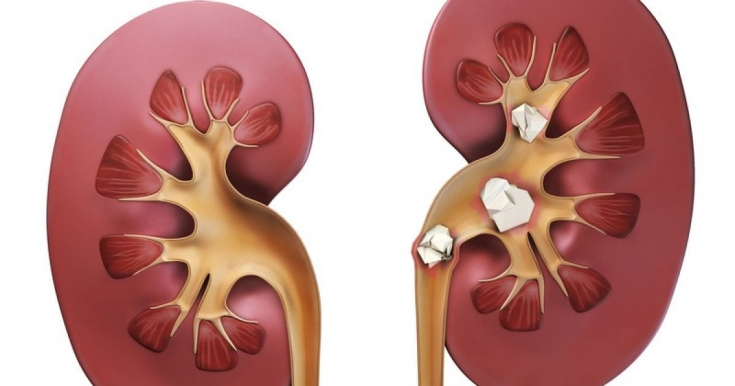People who have problems with the urinary system often experience pain or discomfort in the lower back. Usually pain in such cases occurs on one side. Sometimes during urination, an admixture of blood and a sharp pain can be detected. These are all unpleasant symptoms of kidney stones. About 200 million people around the globe suffer from urolithiasis, agrees estet-portal.com. Why stones form in this organ and how to get rid of kidney stones, we will tell today.
Why do kidney stones form?
Kidney stones form if the diet is too high in calcium and magnesium and does not include enough water and acids. As a result, sand is formed in the kidneys, which eventually degenerates into stones.
They can also be caused by:
- Heredity,
- Previous inflammatory diseases of the genitourinary system (cystitis and pyelonephritis),
- Surgical intervention in the urinary system,
- Birth defects of the urinary system,
- Deficiency of vitamins A and D,
- Use of sulfa drugs in long-term therapy,
- Abuse of heavy food: fried, smoked, salty.
Symptoms of urolithiasis
In each individual case, the symptoms of the occurrence of kidney stones are quite different. Often, for a long time, the patient is unaware of their illness until the stones become too large or until several stones form.
Typical symptoms are:
- pain in the groin,
- side,
- in the lumbar region.
Most of the stones can fall off on their own if their size does not exceed 0.5cm. This happens in about 70% of cases, but it causes a condition of renal colic.
Colic can be extremely acute, capable of causing a painful shock.
In addition to pain, signs of renal colic in the kidneys may include vomiting, fever up to 38-40 degrees, pain when urinating, cloudy urine, the presence of sand or stones in the urinary excretion. How, then, to get rid of kidney stones that are larger than 0.5 cm?
Read also: Diagnosis of urolithiasis: how to find a stone in the kidney
Treatment and diagnosis of kidney stones
To establish an accurate diagnosis, a thorough examination is necessary. It is carried out using special equipment. The patient will also need to take a blood and urine test. It is possible and necessary to remove stones from the kidneys, otherwise they cause inflammatory processes. To date, there are several treatment options:
- conservative treatment,
- contactless crushing,
- intracorporeal lithotripsy,
- surgical method.
Use of conservative treatment
Treatment of any patient is absolutely individual, therefore, an experienced specialist should decide to apply this or that method. If the stones do not exceed the size of half a centimeter, doctors suggest using conservative treatment. Usually we are talking about taking antispasmodic drugs, due to which all spasmodic areas of the urinary system are relaxed and the stone itself leaves the body.
Phyto-collections and diuretics are prescribed as additional means in such cases. After successful completion of this therapy, it is necessary to apply diuretic therapy 2 times a year.
Application of crushing method by non-contact method
If the deposits are larger than half a centimeter, they can be removed using extracorporeal shock wave lithotripsy. For this, electromagnetic waves are used. The removal session lasts 45 minutes. Up to 5 sessions are usually required for complete removal of calculi. Diuretics and plenty of fluids are added to the therapy to speed up the process of cleansing the body.
Intracorporeal lithotripsy method
If the stones are not located in the kidney itself, but in the ureter, then intracorporeal lithotripsy is chosen as the treatment method. In this case, only 1 session is needed to cleanse the body of a foreign calculus. This intervention is performed under anesthesia with a laser. At the same time, the remains of crushed stones are removed immediately, without forcing the body to get rid of them on its own.
Surgery
More advanced stages require surgery. However, at present, it is carried out only in 5% of cases if the stones occupy a large part of the kidney cavity. Nowadays, there are several types of operations to remove kidney stones. Usually, with this treatment, the kidney is cut and the formed calculus is removed.
It is considered the oldest and most dangerous method, an open abdominal operation is performed. After it, the patient endures the rehabilitation period for a long and difficult time. Also, there are many side effects as the development of a number of other diseases. Among them are such ailments as pneumonia. Often, rehabilitation is accompanied by bleeding and relapses.
Prevention of kidney stones
An individual diet is prescribed for each patient. It depends on the type of disease and the chemical composition of kidney stones. But everyone is advised to avoid foods high in calcium and magnesium. These components are contained in:
- canned meat and fish,
- dairy products and sausages,
- radishes and legumes.
Alcoholic and carbonated drinks should be avoided during the treatment period. For recovery, it is necessary to consume these foods in moderation.
For a speedy recovery, you should pay attention to foods containing vitamin C. Its acids will help neutralize harmful bacteria and viruses, as well as break down kidney stones.
Vitamin C should be taken both in tablets and in food. It is found in citrus products: blueberries, strawberries, pineapple, cranberries, tomatoes, and many others. In order for sand and stones in the kidneys to leave the body quickly, it is necessary to wash them out with water. You need to drink at least eight glasses of water a day. A couple of glasses of water can be replaced with juice from the above products or a decoction of cranberries or rose hips.
Remember, the key to health lies in healthy food! Read more about the right diet in the articles on estet-portal.com.







Add a comment